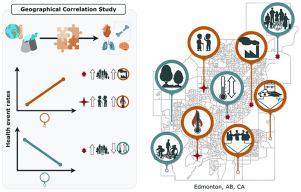Urban Climate ( IF 6.0 ) Pub Date : 2022-07-12 , DOI: 10.1016/j.uclim.2022.101225 McKenzie H. Tilstra , Charlene C. Nielsen , Ishwar Tiwari , C. Allyson Jones , Alvaro Osornio Vargas , Bernadette Quemerais , Okan Bulut , Jordana Salma , Shelby S. Yamamoto

|
We investigated health risks associated with climate and air pollution hazards and community covariates to generate insights into the resilience of older adults and immigrants at the community level in a northern urban center in the Canadian prairies. Communities with higher proportions of older adults were associated with increased cardiovascular, injury, mental, and respiratory health event rates. Notably, heat effects on injury rates impacted communities with higher percentages of older adults (Prevalence Rate Ratio (PRR) [95%CI] 1.110 [1.011, 1.219] at 25% ≥65 years). Ozone effects on cardiovascular event rates exhibited similar trends. Areas with higher percentages of immigrants generally had lower rates of hxealth events. However, increasing diurnal temperature range became a risk factor for respiratory health rates where there were higher percentages of refugees (PRR 1.205 [1.004, 1.447] at 20%). Industrial emission effects on injury and respiratory health rates also amplified in areas with higher percentages of refugees (PRR 1.127 [1.058, 1.200]; 1.130 [1.050, 1.216] at 20%). Similar effects were observed for mental health event rates and total immigrants. Greater neighborhood material and social deprivation were significant risk factors for increased health event rates across outcomes. Future work should focus on disproportionately affected vulnerable populations to address community-level resilience.
中文翻译:

在加拿大埃德蒙顿探索社会环境对社区健康的影响,以了解气候变化中的老年人和移民风险
我们调查了与气候和空气污染危害以及社区协变量相关的健康风险,以深入了解加拿大大草原北部城市中心社区层面的老年人和移民的复原力。老年人比例较高的社区与心血管、损伤、精神和呼吸系统健康事件的发生率增加有关。值得注意的是,热对伤害率的影响影响了老年人比例较高的社区(患病率比 (PRR) [95%CI] 1.110 [1.011, 1.219],25% ≥ 65 岁)。臭氧对心血管事件发生率的影响表现出类似的趋势。移民比例较高的地区通常健康事件发生率较低。然而,在难民比例较高的地方(PRR 1.205 [1.004, 1.447] 为 20%),昼夜温度范围的增加成为呼吸系统健康率的风险因素。在难民比例较高的地区,工业排放对伤害和呼吸健康率的影响也扩大了(PRR 1.127 [1.058, 1.200];1.130 [1.050, 1.216],占 20%)。心理健康事件发生率和移民总数也观察到了类似的影响。更大的邻里物质和社会剥夺是不同结果中健康事件发生率增加的重要风险因素。未来的工作应侧重于受影响不成比例的弱势群体,以解决社区层面的复原力问题。在难民比例较高的地区,工业排放对伤害和呼吸健康率的影响也扩大了(PRR 1.127 [1.058, 1.200];1.130 [1.050, 1.216],占 20%)。心理健康事件发生率和移民总数也观察到了类似的影响。更大的邻里物质和社会剥夺是不同结果中健康事件发生率增加的重要风险因素。未来的工作应侧重于受影响不成比例的弱势群体,以解决社区层面的复原力问题。在难民比例较高的地区,工业排放对伤害和呼吸健康率的影响也扩大了(PRR 1.127 [1.058, 1.200];1.130 [1.050, 1.216],占 20%)。心理健康事件发生率和移民总数也观察到了类似的影响。更大的邻里物质和社会剥夺是不同结果中健康事件发生率增加的重要风险因素。未来的工作应侧重于受影响不成比例的弱势群体,以解决社区层面的复原力问题。







































 京公网安备 11010802027423号
京公网安备 11010802027423号